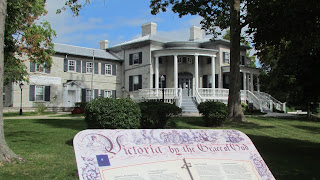Well, thank goodness for Dr. Jennifer McKendry. I've mentioned Kingston's well-known and much-published architectural historian in a number of posts over my love affair with her city.
Today, I appreciate her even more, as she is THE ONLY source I could locate which references a most unique and wonderful structure in that city, the Waldron Tower. Built in 1968, this building, originally a student nurses' residence, and now a co-ed residence for Queen's students, is easily underestimated, amid the Collegiate Gothic buildings of the campus, the early incomparable Summerhill, and the homes of the well to do along King Street.
There are student videos posted on the Queens residence services site, showing off the utilitarian concrete interiors, and the windows - as soon as I had drawn his attention to the building, my design engineer husband noticed that the design provides each of them with a view of Lake Ontario, just across the street.
The marriage of the stepped brick tower with the textured stone and curving concrete elements of the one-storey wing - likely the student common area at one time? - is appealing. I couldn't stop looking and shooting.
Curving, smooth, undecorated surfaces of the reverse arch portico contrast with the rough stone walling. The rotunda is supported by an external skeleton of concrete spines, separating long narrow windows.
It's a bland beige brick tower at first glance, but with such caprice, embracing all that was iconoclastic in the International Style, everywhere one looks. McKendry includes a brief but laudatory comment: "the city building that most successfully shows the potential for beauty in the International Style." She mentions the curved lines and broken cornice.
More and more curves in concrete.
Look up, look way up. McKendry suggests this very tall building looks light because of the broken cornice and curved lines.
Incidentally, the book where I finally found some architectural mention of Waldron Tower is
Modern Architecture in Kingston - A survey of 20th century buildings, self-published, 2014, by Jennifer McKendry.
Notice the tiny square porthole like windows on the slightly concave end wall?
Sorry if this post trails out a bit. As undisciplined as I was while taking photos, I have been even more profligate at sharing them. And as I have complained before, "new" Blogger does not allow portrait oriented photos to be moved into a comfy side by side arrangement. And that's an improvement how?
The datestone - 1968. I had to sneak up what looked like a private drive, behind the wonderful Katherine Bermingham Macklem house which now houses a hospital department, to find it. Unmistakeable. The whole building a celebration of what I knew to be its era.
In closing. A Streetview
link, if you fancy a wander yourself.

























